Wandering around the mountain top didn’t take me very far today. Here’s a few snaps of some flowering herbs. These herbs are growing in a protected area next to the house that gets morning and early afternoon sun.
Basil is one of my favorite herbs. The aroma of a crushed basil leaf awakens the senses. Basil can dress up any regular garden salad and goes exceptionally well with tomatoes. Basil has relatively large leaves for an herb, measuring 2 or more inches in length and an inch or so in width. The light green basil leaves feel very pliable and smooth and are arranged opposite one another going up the stem.

Light green opposite leaves of basil.
Flowering tops of basil are easily recognized as they appear like groups of little circular canopies with small white blossoms hanging underneath each awning. Circlets of basil blooms are separated by half and inch or more and there will be 10-12 groups of blooms on the terminal portion of the basil stem. Below you can see half a dozen basil flower spikes.
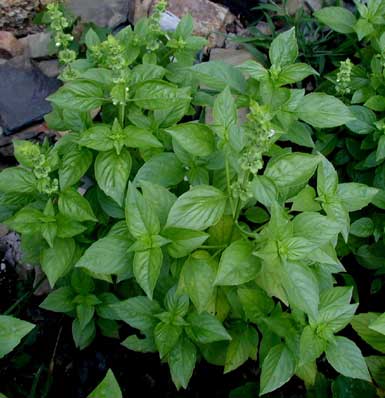
Terminal flower spikes in basil.
The oregano is flowering now and has tiny white blossoms. The leaves next to the flowering tops are tiny compared to the typical leaves, perhaps a tenth the size. Below the flowering oregano tops are seen in the foreground and regular oregano leaves in the background.

Flowering tops of oregano with very tiny white blossoms and tiny leaves.
Catnip grows wild here in southcentral Pennsylvania and we make sure to spread a few seeds around to please the kitties. I like cats a lot more than I like mice and other rodents! The catnip plant here volunteered next to the flagstone walkway just outside the garage. Whenever leaving or entering the garage the scent of catnip fills the air as the car brushes past. Here, we see a bumblebee pollinating the small white catnip flowers.
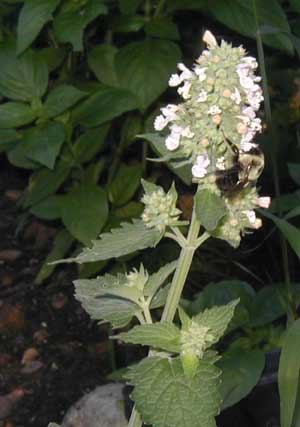
Bumblebee pollinating the catnip blossoms.
Catnip, Nepeta cataria, is a member of the mint family having opposite leaves that are somewhat arrow shaped. The main stem in the image below was snipped to induce bushiness and indeed, new stems arose from the leaf axils. The new stems now have terminal flower clusters with many small white-to-pinkish flowers.
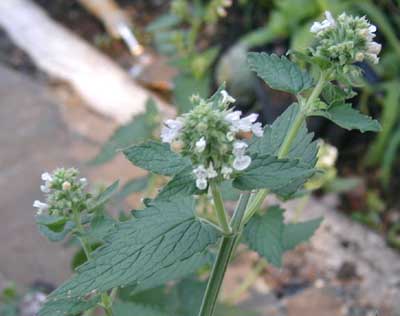
Pruning the tops of catnip stems will produce a bushier plant.
Catnip leaves feel somewhat soft and have a distinct shape. At the base the leaves are squared off, have a jagged appearance, and attach to the main stem with their own short stem. The best indicator that you have found catnip is to crush a leaf and smell the minty aroma. Rub a leaf on your pants or sleeves to act as a bug repellent. Scientists are studying a compound found in catnip, called nepetalactone, for its pest resisting properties. Most catnip leaves are left untouched by chewing insects.
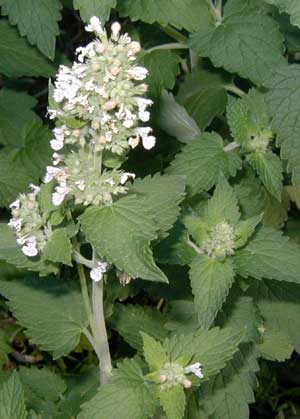
Pinkish to white blossoms of catnip are packed together at the top of stems.
The one wild flower I did capture today was the Asiatic Dayflower, Commelina communis, an alien that appears in wasteplaces and along roadsides or other disturbed areas. We have a few batches growing at the edge of woods and along the lane. A member of the spiderwort family the Dayflower has radially symmetrical flowers having three petals, two blue petals on top and a third petal below that is white. The simple leaves are alternate and wrap around the stem at the leaf base giving it a sheath-like appearance.
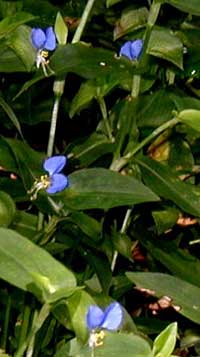
Asiatic Dayflowers last for only one day!
Wow that was unusual. I just wrote an extremely long comment but after I clicked submit my comment didn’t show up. Grrrr… well I’m not writing all that over again. Anyway, just wanted to say superb blog!
Hey there, Diet Food Junkie….
Many blogs have comments moderated so the owner or administrator can manually check for inappropriate content. That’s why your initial comment didn’t show – sorry for the confusion. Glad to have you stop by and enter the fray!
Stop by again! Thanks for the nice compliment!!